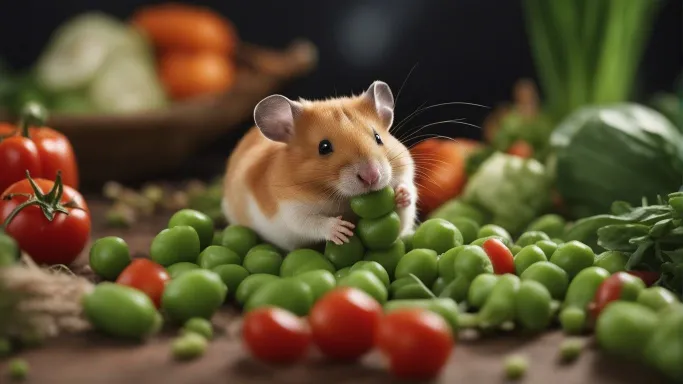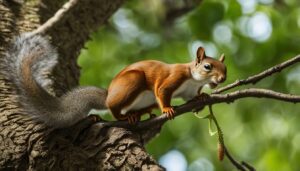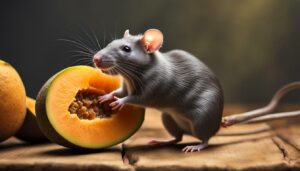If you’re unsure about whether your hamster can enjoy peas as part of its diet, this comprehensive guide will provide all the information you need.
Factual data: Hamsters can eat peas, but there are a few things to consider. Peas are a healthy addition to a hamster’s diet as they provide dietary fiber, manganese, folate, iron, and vitamin B6.
However, peas should only be fed in moderation and not as a sole diet. Feeding too many peas can lead to obesity and diabetes in hamsters due to their high sugar and fat content.
It is important to follow a feeding guide based on the hamster’s breed. Syrian hamsters can have up to 6 peas per week, Roborovski hamsters can have up to 3 peas per week, while Dwarf hamsters should not be fed peas at all.
Peas should be served soft or mushy, and not frozen. It is also recommended to slice peas in half to prevent choking in small hamster breeds.
Overall, peas can be a nutritious snack for hamsters when given in moderation and as part of a balanced diet.
Key Takeaways:
- Peas can be included in a hamster’s diet but should be fed in moderation.
- Peas provide dietary fiber, manganese, folate, iron, and vitamin B6 for hamsters.
- Feeding too many peas can lead to obesity and diabetes in hamsters.
- Syrian hamsters can have up to 6 peas per week, Roborovski hamsters can have up to 3 peas per week, while Dwarf hamsters should not be fed peas at all.
- Peas should be served soft or mushy and sliced in half for small hamster breeds to prevent choking.
The Nutritional Value of Peas for Hamsters
Peas offer several nutritional benefits for hamsters, making them a healthy addition to their diet. These small, round green vegetables are packed with dietary fiber, manganese, folate, iron, and vitamin B6.
The dietary fiber found in peas aids in maintaining a healthy digestive system for your hamster, promoting regular bowel movements and preventing constipation.
Manganese and folate are essential minerals that support the overall health and proper functioning of your hamster’s body.
Iron is crucial for the production of red blood cells, which carry oxygen throughout the body. Including peas in your hamster’s diet can help prevent anemia and ensure proper oxygenation of tissues.
Vitamin B6, on the other hand, is essential for several physiological processes, including protein metabolism and maintaining a healthy immune system.
While peas do offer these nutritional benefits, it is essential to remember that they should only be fed in moderation.
Feeding too many peas can lead to health problems such as obesity and diabetes in hamsters due to their high sugar and fat content.
It is crucial to follow a feeding guide based on your hamster’s breed to ensure they receive the right amount of peas.
Syrian hamsters can have up to 6 peas per week, Roborovski hamsters can have up to 3 peas per week, while Dwarf hamsters should not be fed peas at all.
| Hamster Breed | Pea Intake per Week |
|---|---|
| Syrian Hamsters | Up to 6 peas |
| Roborovski Hamsters | Up to 3 peas |
| Dwarf Hamsters | No peas |
When serving peas to your hamster, it is important to prepare them properly. Peas should be served soft or mushy, as hard peas can pose a choking hazard.
To prevent choking in small hamster breeds, it is recommended to slice peas in half before serving them.
Avoid feeding frozen peas to your hamster as they can be too hard and may cause discomfort or dental issues.
Remember to incorporate peas as part of a balanced diet for your hamster, along with other safe and nutritious foods, to ensure they receive all the necessary nutrients for optimal health.
Considerations for Feeding Peas to Hamsters
While peas can be a nutritious snack for hamsters, there are some considerations to keep in mind when feeding them this vegetable.
Peas provide essential dietary fiber, manganese, folate, iron, and vitamin B6, which can contribute to a balanced diet for your furry friend.
However, it is important to remember that peas should not be the sole diet of a hamster and should only be given in moderation.
Feeding too many peas to your hamster can lead to health issues such as obesity and diabetes. Peas have high sugar and fat content, which can be detrimental to their overall well-being if consumed excessively.
It is crucial to follow a feeding guide based on your hamster’s breed to ensure you are providing the right amount of peas as a treat.
As a general guideline, Syrian hamsters can have up to 6 peas per week, while Roborovski hamsters can have up to 3 peas per week.
However, Dwarf hamsters should not be fed peas at all due to their higher susceptibility to diabetes. It is essential to monitor your hamster’s weight and overall health when introducing peas into their diet and make adjustments accordingly.
| Hamster Breed | Recommended Pea Intake |
|---|---|
| Syrian Hamsters | Up to 6 peas per week |
| Roborovski Hamsters | Up to 3 peas per week |
| Dwarf Hamsters | No peas recommended |
When serving peas to your hamster, it is important to prepare them appropriately. Peas should be soft or mushy, not frozen. Freezing peas can make them too hard and can pose a choking hazard for your hamster. Additionally, it is recommended to slice peas in half, especially for small hamster breeds, to further reduce the risk of choking. Always prioritize your hamster’s safety and well-being when choosing how to serve peas as a treat.
Remember, peas should be incorporated as part of a balanced diet for your hamster. Alongside peas, there are other safe vegetables that can be included in their diet, such as carrots, broccoli, and spinach. It is important to offer a variety of vegetables to ensure your hamster receives a diverse range of nutrients.
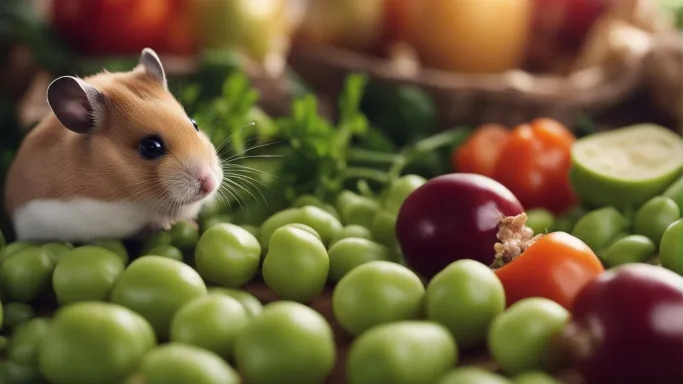
Recommended Pea Intake for Different Hamster Breeds
The recommended intake of peas varies depending on the breed of hamster, with different portion sizes to ensure their overall health. When feeding peas to hamsters, it is important to consider their size and nutritional needs. For larger breeds like Syrian hamsters, up to 6 peas per week can be safely given. These peas should be served soft or mushy, as frozen peas can be too hard for hamsters to chew. Slicing peas in half is also recommended to prevent choking, especially for smaller breeds such as Roborovski hamsters.
According to research and hamster experts, Dwarf hamsters, including Campbell’s and Winter Whites, should not be fed peas at all. These smaller breeds have different dietary requirements and are more prone to health issues related to their diet. Instead, it is advisable to focus on other safe vegetables that can provide them with the necessary nutrition without potential risks.
It is crucial to integrate peas into a balanced diet for hamsters and not rely on them as the sole source of nutrients. Hamsters are omnivores, so a varied diet is essential for their well-being. Alongside peas, other safe vegetables that can be included in a hamster’s diet include carrots, broccoli, cucumbers, and bell peppers. These vegetables offer additional vitamins and minerals that contribute to a hamster’s overall health.
| Hamster Breed | Recommended Pea Intake |
|---|---|
| Syrian Hamster | Up to 6 peas per week |
| Roborovski Hamster | Up to 3 peas per week |
| Dwarf Hamster (Campbell’s and Winter Whites) | Not recommended |
To maintain a balanced diet and prevent health issues, moderation is key when it comes to feeding hamsters peas or any other food. It is important to provide a variety of safe foods, monitor portion sizes, and consult with a veterinarian for specific dietary recommendations based on the hamster’s breed, age, and overall health.
Potential Risks of Overfeeding Peas to Hamsters
While peas can provide nutritional benefits to hamsters, overfeeding can lead to health issues such as obesity and diabetes. Hamsters have small digestive systems and require a well-balanced diet to maintain their overall health. It’s important to understand the potential risks associated with feeding peas in excess and to follow guidelines to ensure the well-being of your furry friend.
Obesity is a common concern among hamsters, and overfeeding high-sugar foods like peas can contribute to weight gain. Excess weight can lead to a range of health problems, including decreased mobility, respiratory issues, and an increased risk of heart disease. To prevent obesity, it is crucial to provide portioned servings of peas based on your hamster’s breed and size.
Another risk of overfeeding peas is the development of diabetes in hamsters. Peas contain natural sugars, and excessive consumption can lead to an imbalance in blood sugar levels. This can result in diabetes, a chronic condition that affects the hamster’s ability to regulate their blood sugar. Symptoms of diabetes in hamsters include increased thirst, frequent urination, and weight loss. It is vital to monitor your hamster’s pea intake and consult a veterinarian if you notice any concerning changes in their behavior or health.
| Hamster Breed | Maximum Weekly Pea Intake |
|---|---|
| Syrian Hamsters | Up to 6 peas per week |
| Roborovski Hamsters | Up to 3 peas per week |
| Dwarf Hamsters | Not recommended |
To ensure your hamster’s safety, it is essential to serve peas in a way that minimizes the risk of choking.
Peas should be served soft or mushy, as frozen peas can be too hard for hamsters to chew. For small hamster breeds, it is recommended to slice peas in half to prevent choking incidents.
Always monitor your hamster while they are eating and remove any uneaten portions to avoid spoilage.
In conclusion, while peas can be a nutritious addition to a hamster’s diet, it is vital to feed them in moderation.
Overfeeding peas can lead to obesity and diabetes in hamsters due to their high sugar and fat content.
Following a feeding guide based on your hamster’s breed and serving peas in an appropriate manner will help ensure their overall well-being.
Remember to consult a veterinarian if you have any concerns about your hamster’s diet or health.
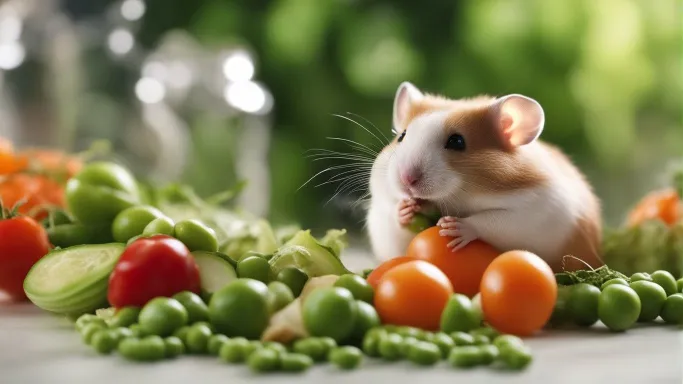
Serving Peas to Hamsters
To ensure the safety and enjoyment of your hamster, it’s important to serve peas in a way that is suitable for their size and eating habits. Peas should be served soft or mushy, as hard peas can pose a choking hazard to small hamster breeds. You can achieve this by cooking the peas until they are tender or by steaming them until they are easily mashed with a fork. Avoid serving frozen peas, as they can be too hard for your hamster to eat.
In addition to serving peas in a soft consistency, it’s recommended to slice them in half for small hamster breeds like Roborovski and Dwarf hamsters. This helps to prevent choking and makes it easier for them to consume the peas without any issues. For larger breeds like Syrian hamsters, you can serve whole peas as long as they are soft and not frozen.
When offering peas to your hamster, it’s important to remember that they should be given as a treat or supplement to their regular diet, not as a main meal. Peas should be served in moderation, alongside a balanced diet that includes a variety of safe foods for hamsters. This ensures that your hamster receives all the essential nutrients they need to stay healthy.
Table: Recommended Pea Intake for Different Hamster Breeds
| Hamster Breed | Recommended Pea Intake |
|---|---|
| Syrian Hamsters | Up to 6 peas per week |
| Roborovski Hamsters | Up to 3 peas per week |
| Dwarf Hamsters | No peas |
Following these serving guidelines and portion sizes will help ensure that your hamster can safely enjoy the nutritional benefits of peas without any adverse health effects. Remember to always monitor your hamster’s weight and adjust their diet accordingly to prevent obesity or other health issues related to overfeeding.
Incorporating Peas into a Balanced Diet for Hamsters
Peas can be a valuable addition to a hamster’s overall diet, but it’s crucial to provide a variety of safe and nutritious foods to ensure their well-being. When incorporating peas into a hamster’s diet, it’s important to remember that they should be served in moderation and as part of a balanced meal plan. Peas offer several nutritional benefits, including dietary fiber, manganese, folate, iron, and vitamin B6, which can support your hamster’s overall health.
To incorporate peas into your hamster’s diet, you can offer them as a snack a few times a week. Syrian hamsters, which are larger in size, can have up to 6 peas per week. Roborovski hamsters, on the other hand, should be given a smaller portion and can have up to 3 peas per week. Dwarf hamsters, due to their small size, should not be fed peas at all. It’s important to follow these guidelines to ensure your hamster’s dietary needs are met without overfeeding.
When serving peas to your hamster, it’s best to serve them soft or mushy. Avoid feeding them frozen peas as the texture may be too hard for your hamster to chew. Additionally, it is recommended to slice the peas in half, especially for small hamster breeds, to prevent choking hazards. By taking these precautions, you can ensure your hamster enjoys the nutritional benefits of peas without any risks.
| Hamster Breed | Maximum Pea Intake Per Week |
|---|---|
| Syrian Hamsters | Up to 6 peas |
| Roborovski Hamsters | Up to 3 peas |
| Dwarf Hamsters | No peas |
Remember, while peas can provide nutritional benefits, they should not make up the majority of your hamster’s diet. It’s essential to provide a well-rounded meal plan that includes a variety of safe vegetables and high-quality hamster pellets. By offering a balanced diet, you can ensure your hamster receives the necessary nutrients for optimal health and well-being.
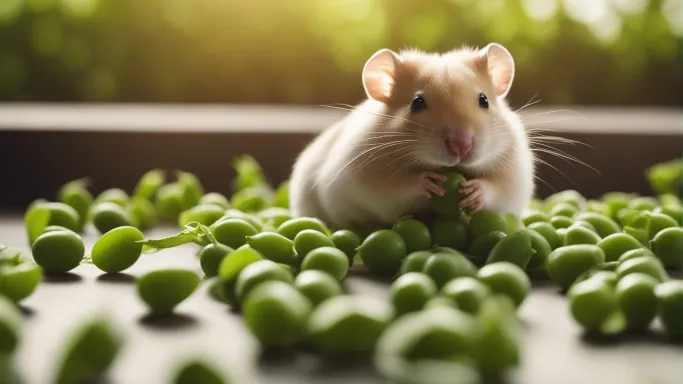
Other Safe Vegetables for Hamsters
In addition to peas, there are several other vegetables that you can safely feed to your hamster to provide them with a diverse and balanced diet. These vegetables are not only nutritious but also offer different flavors and textures to keep your furry friend satisfied.
One great option is carrots. Hamsters love the crunchiness of carrots, and they are packed with vitamin A, which is essential for their eye health. You can offer small, bite-sized pieces of carrots as a regular part of their diet.
Another safe vegetable for hamsters is broccoli. Not only is broccoli rich in vitamins and minerals, but it also adds variety to their meals. Steam or blanch the florets to make them easier for your hamster to chew and digest.
Safe Vegetables for Hamsters:
| Vegetable | Feeding Frequency |
|---|---|
| Peas | Up to 6 per week for Syrian hamsters, up to 3 per week for Roborovski hamsters |
| Carrots | 1-2 times per week |
| Broccoli | 1-2 times per week |
Leafy greens such as spinach and kale are also safe for hamsters. These vegetables are rich in vitamins and minerals, including calcium, which is essential for their bone health. Offer small portions of these greens once or twice a week.
Remember to introduce new vegetables gradually and in small amounts to ensure that your hamster can tolerate them well. It’s also important to wash all vegetables thoroughly before serving to remove any pesticides or dirt.
By including a variety of safe vegetables in your hamster’s diet, you can provide them with a range of nutrients and flavors to keep them happy and healthy. Just remember to feed vegetables in moderation and consult with a veterinarian if you have any concerns about your hamster’s diet.
The Importance of Moderation in Hamster Diet
Moderation is key when it comes to feeding your hamster, including peas, to ensure their overall health and well-being. While peas can be a nutritious addition to a hamster’s diet, it is important not to overfeed them. Remember, hamsters have small digestive systems and can easily develop health issues if fed an imbalanced diet.
To maintain a balanced diet, peas should be offered as a treat in controlled portions, rather than a staple food. Feeding too many peas can lead to weight gain, obesity, and even diabetes in hamsters, as peas are relatively high in sugar and fat content. It is recommended to follow specific guidelines based on your hamster’s breed, as different breeds have different nutritional needs.
For example, Syrian hamsters can safely consume up to 6 peas per week, while Roborovski hamsters should be limited to no more than 3 peas per week. Dwarf hamsters, however, should not be fed peas at all due to their smaller size and different dietary requirements. It is crucial to consider these guidelines to prevent potential health issues in your furry friend.
In addition to portion control, it is essential to prepare peas in a hamster-friendly way. Peas should be served soft or mushy to make them easier to chew and digest. Avoid feeding frozen peas, as they can be too hard for hamsters to eat. To prevent choking, especially in small hamster breeds, it is recommended to slice peas in half before offering them as a snack.
Remember, peas should not be the only vegetable in your hamster’s diet. It is important to provide a variety of safe vegetables to ensure they receive a balanced range of nutrients. Other vegetables that hamsters can enjoy include carrots, broccoli, and leafy greens such as spinach and kale. Always introduce new foods gradually and monitor your hamster’s reaction to ensure they tolerate them well.
| Hamster Breed | Recommended Weekly Pea Intake |
|---|---|
| Syrian Hamster | Up to 6 peas |
| Roborovski Hamster | Up to 3 peas |
| Dwarf Hamster | Not recommended |
In summary, while peas can be a nutritious snack for hamsters, it is crucial to feed them in moderation and as part of a balanced diet.
Follow the recommended guidelines for your hamster’s breed and ensure the peas are prepared in a hamster-friendly manner.
By providing a varied and controlled diet, you can help your hamster maintain optimal health and well-being.
Conclusion
Peas can be a nutritious addition to your hamster’s diet, but it’s crucial to provide them in moderation alongside a variety of safe and nutritious foods.
Hamsters can enjoy the benefits of peas, such as fiber, manganese, folate, iron, and vitamin B6. However, it’s important to remember that peas should not be the sole diet of your hamster.
Feeding too many peas can lead to obesity and diabetes, as they are high in sugar and fat.
When incorporating peas into your hamster’s diet, it’s essential to follow a feeding guide based on their breed.
Syrian hamsters can have up to 6 peas per week, while Roborovski hamsters can have up to 3 peas per week.
However, Dwarf hamsters should not be fed peas at all, as their dietary needs differ. It’s vital to be mindful of portion sizes and avoid overfeeding.
When serving peas to your hamster, make sure they are soft or mushy, as this will make them easier to eat.
It is also recommended to slice peas in half for small hamster breeds to prevent choking. By taking these precautions, you can ensure that your hamster safely enjoys the nutritional benefits of peas.
Remember, a balanced diet is key to your hamster’s overall health. While peas can be a nutritious snack, it’s important to incorporate other safe vegetables and foods to provide a well-rounded diet.
Variety is essential to ensure that your hamster receives all the necessary nutrients for optimal health.
So, when it comes to feeding your hamster peas, remember the golden rule: moderation is key. By offering peas as part of a balanced and controlled diet, you can provide your furry friend with a healthy and enjoyable eating experience.
Keep their dietary needs in mind, and your hamster will reap the nutritional benefits of peas while staying happy and healthy.
FAQ
Q: Can hamsters eat peas?
A: Yes, hamsters can eat peas, but there are a few things to consider.
Q: What is the nutritional value of peas for hamsters?
A: Peas provide dietary fiber, manganese, folate, iron, and vitamin B6, making them a healthy addition to a hamster’s diet.
Q: Are there any considerations for feeding peas to hamsters?
A: Yes, peas should only be fed in moderation and not as a sole diet. Feeding too many peas can lead to obesity and diabetes in hamsters due to their high sugar and fat content.
Q: How many peas can different hamster breeds have?
A: Syrian hamsters can have up to 6 peas per week, Roborovski hamsters can have up to 3 peas per week, while Dwarf hamsters should not be fed peas at all.
Q: What are the potential risks of overfeeding peas to hamsters?
A: Overfeeding peas can lead to obesity and diabetes in hamsters due to their high sugar and fat content.
Q: How should peas be served to hamsters?
A: Peas should be served soft or mushy, and it is recommended to slice them in half to prevent choking in small hamster breeds.
Q: How should peas be incorporated into a hamster’s diet?
A: Peas should be part of a balanced diet for hamsters, along with other safe and nutritious foods.
Q: Are there other safe vegetables for hamsters?
A: Yes, there are other vegetables that are safe for hamsters to consume. It’s important to provide a variety of options in their diet.
Q: Why is moderation important in a hamster’s diet?
A: Moderation is crucial to ensure a balanced and portioned diet for hamsters, including the consumption of peas and other foods.

